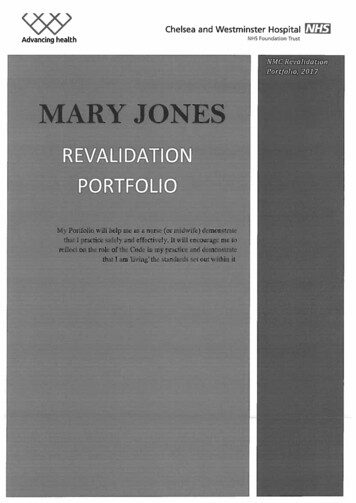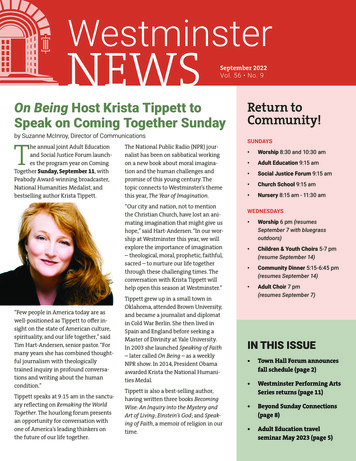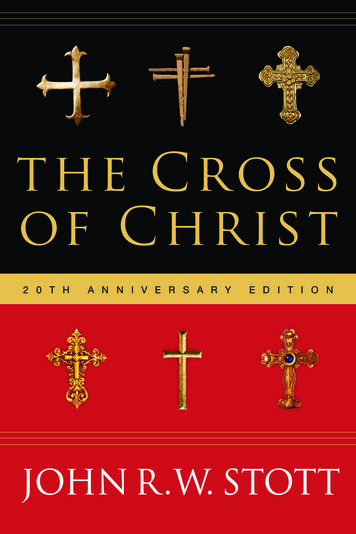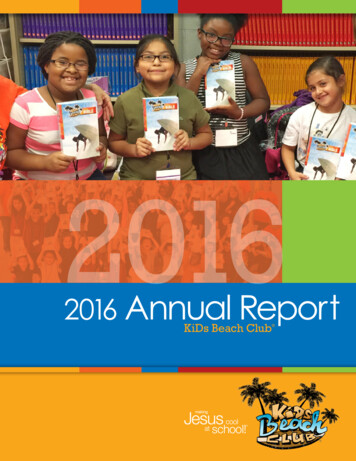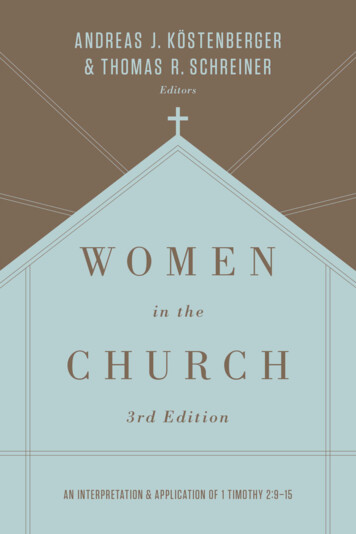
Transcription
“A pivotal text behind a major problem deserves a major book. The pivotal textis 1 Timothy 2:9–15. The major problem is how men and women relate to eachother in teaching and leading the Christian church. And the major book is Womenin the Church. There is none more thorough or careful or balanced or biblical. Theappearance of a third edition is added confirmation of the book’s abiding value.”John Piper, Founder, desiringGod.org; Chancellor, Bethlehem College andSeminary“In an age when ideological dogmatism and sheer speculative fancy often displacesober exegesis, it is refreshing to read a book that tries to wrestle with what the textis saying without cleverly domesticating it. This book needs to be read by all sidesin the current controversy.”D. A. Carson, Research Professor of New Testament, Trinity EvangelicalDivinity School; Cofounder, The Gospel Coalition“Read it to the end! These chapters unfold the biblical text in depth; they connect uswith a world of scholars on all sides; and they interact with a rapidly growing layerof women’s voices writing and speaking on the subject. I’m thankful for a book focused both on academic precision and on loving care for the church, Christ’s bride.”Kathleen B. Nielson, Director of Women’s Initiatives, The Gospel Coalition“The third edition of this outstanding volume of integrated essays about the ministry of women in the Christian church (particularly in relation to 1 Timothy 2) isthe most comprehensive treatment to date on the subject. At significant points thisseries of grammatical, linguistic, exegetical, hermeneutical, and theological essaystakes us beyond earlier editions and makes a fresh contribution to our knowledge.The contributors have interacted extensively and courteously with contemporaryscholarship as they have sought to grapple with the teaching of God’s Word onthis vital issue of women’s ministry and to work through some of its implications.Highly recommended.”Peter T. O’Brien, Former Vice-Principal and Senior Research Fellow andEmeritus Faculty Member, Moore Theological College, Australia“In an age when assertions abound concerning the meaning of this text, the contributors have not only presented the most thoroughgoing and decisive case forthe traditional view of 1 Timothy 2:9–15 now available but have also provided ahandbook of solid interpretive methodology. Whether or not one agrees with theirconclusions, the reader will find the issues clarified, the evidence evaluated, and thetext carefully analyzed and applied. I heartily recommend this book to all who arewilling to confront and be confronted by the biblical text once again.”Scott J. Hafemann, Reader in New Testament, University of St. Andrews
Women in the Church
Women in the ChurchAn Interpretation and Applicationof 1 Timothy 2:9–15Third EditionEdited by Andreas J. Köstenbergerand Thomas R. SchreinerW H E AT O N , I L L I N O I S
Women in the Church: An Interpretation and Application of 1 Timothy 2:9–15Copyright 1995, 2005, 2016 by Andreas J. Köstenberger and Thomas R. SchreinerPublished by Crossway1300 Crescent StreetWheaton, Illinois 60187All rights reserved. No part of this publication may be reproduced, stored in a retrieval system, or transmitted inany form by any means, electronic, mechanical, photocopy, recording, or otherwise, without the prior permission of thepublisher, except as provided for by USA copyright law. Crossway is a registered trademark in the United States ofAmerica.Third edition 2016Published originally as Women in the Church: A Fresh Analysis of 1 Timothy 2:9–15 in 1995 by Baker Books, a divisionof Baker Book House Company, and in a second edition as Women in the Church: An Analysis and Application of1 Timothy 2:9–15 in 2005 by Baker Academic, a division of Baker Publishing Group.Cover design: Dual Identity, Inc.First printing of Crossway reprint edition 2016Printed in the United States of AmericaScripture quotations marked AT are the author’s translation.Scripture quotations marked CEB are taken from the Common English Bible , copyright 2011. Used by permission.All rights reserved.Scripture quotations marked ESV are from the ESV Bible (The Holy Bible, English Standard Version ), copyright 2001by Crossway, a publishing ministry of Good News Publishers. Used by permission. All rights reserved.Scripture quotations marked HCSB have been taken from The Holman Christian Standard Bible . Copyright 1999,2000, 2002, 2003 by Holman Bible Publishers. Used by permission.Scripture quotations marked ISV are from The International Standard Version . Copyright 1996, 2004 by The ISVFoundation. All rights reserved internationally.Scripture quotations marked KJV are from the King James Version of the Bible.Scripture references marked NAB are from the New American Bible, copyright 1970 by the Confraternity of ChristianDoctrine, Washington, DC, and are used by permission. All rights reserved.Scripture quotations marked NASB are from The New American Standard Bible . Copyright The Lockman Foundation1960, 1962, 1963, 1968, 1971, 1972, 1973, 1975, 1977, 1995. Used by permission.Scripture quotations marked NET are from The NET Bible copyright 2003 by Biblical Studies Press, L.L.C.www.netbible.com. All rights reserved. Quoted by permission.Scripture references marked NIV 1984 are taken from The Holy Bible, New International Version , NIV . Copyright 1973, 1978, 1984 by Biblica, Inc. Used by permission. All rights reserved worldwide.Scripture references marked NIV 2011 are taken from The Holy Bible, New International Version , NIV . Copyright 1973, 1978, 1984, 2011 by Biblica, Inc. Used by permission. All rights reserved worldwide.Scripture quotations marked NJB are from The New Jerusalem Bible, copyright 1985 by Darton, Longman & Todd,Ltd. and Doubleday, a division of Random House, Inc. Reprinted by permission.Scripture references marked NKJV are from The New King James Version. Copyright 1982, Thomas Nelson, Inc. Usedby permission.Scripture references marked NLT are from The Holy Bible, New Living Translation, copyright 1996, 2004. Used bypermission of Tyndale House Publishers, Inc., Wheaton, IL, 60189. All rights reserved.Scripture references marked NRSV are from The New Revised Standard Version. Copyright 1989 by the Division ofChristian Education of the National Council of the Churches of Christ in the U.S.A. Published by Thomas Nelson, Inc.Used by permission of the National Council of the Churches of Christ in the U.S.A.Scripture references marked RSV are from The Revised Standard Version. Copyright 1946, 1952, 1971, 1973 by theDivision of Christian Education of the National Council of the Churches of Christ in the U.S.A.Scripture references marked TLB are from The Living Bible 1971. Used by permission of Tyndale House Publishers,Inc., Wheaton, IL 60189. All rights reserved.Scripture quotations marked TNIV are taken from the Holy Bible, Today’s New International Version. TNIV . Copyright 2001, 2005 by International Bible Society. Used by permission of Zondervan. All rights reserved.All emphases in Scripture quotations have been added by the author.Trade paperback ISBN: 978-1-4335-4961-8ePub ISBN: 978-1-4335-4964-9PDF ISBN: 978-1-4335-4962-5Mobipocket ISBN: 978-1-4335-4963-2Library of Congress Cataloging-in-Publication DataWomen in the church : an interpretation and application of 1 Timothy2:9-15 / edited by Andreas J. Köstenberger and Thomas R. Schreiner.—Third Edition.pages cmIncludes bibliographical references and index.ISBN 978-1-4335-4961-8 (tp)1. Women in Christianity—Biblical teaching. 2. Bible. Timothy, 1st,II, 9-15—Criticism, interpretation, etc. I. Köstenberger, Andreas J.,1957- editor. II. Schreiner, Thomas R., 3 2015011146Crossway is a publishing ministry of Good News Publishers.VP1514252423222113 12 11 10 9 820197 6 518417163 2 1
To all honest seekersfor the truthwho delight in God’s designfor man and woman.Romans 1:18–32
ContentsContributors and Participants 11Abbreviations 15Introduction 191 A Foreign World: Ephesus in the First Century 25S. M. Baugh2 The Meaning of Αὐθεντέω 65Al Wolters3 A Complex Sentence: The Syntax of 1 Timothy 2:12 117Andreas J. Köstenberger4 An Interpretation of 1 Timothy 2:9–15:A Dialogue with Scholarship 163Thomas R. Schreiner5 Familiar Paths and a Fresh Matrix:The Hermeneutics of 1 Timothy 2:9–15 227Robert W. Yarbrough6 New and Old Departures in the Translationof Αὐθεντεῖν in 1 Timothy 2:12 279Denny Burk7 Application: Roundtable Discussion 297Conclusion 341Appendix: LXX and First-Century Greco-RomanSyntactic Parallels to 1 Timothy 2:12 347Andreas J. Köstenberger
Bibliography 363General Index 395Scripture Index 403Ancient Source Index 410
Contributors and ParticipantsContributorsS. M. Baugh (PhD, University of California, Irvine) is Professor ofNew Testament and Chairman of the Department of Biblical Studiesat Westminster Seminary California. He is the author of “1–2 Timothy, Titus” and “Philemon” in the Zondervan Illustrated Bible Backgrounds Commentary, an essay on the Greek family in Marriage andFamily in the Biblical World, and a forthcoming commentary onEphesians.Denny Burk (PhD, The Southern Baptist Theological Seminary) is Professor of Biblical Studies at The Southern Baptist Theological Seminaryin Louisville, Kentucky. He is the author of What Is the Meaning of Sex?and Articular Infinitives in the Greek of the New Testament.Andreas J. Köstenberger (PhD, Trinity Evangelical Divinity School) isSenior Research Professor of New Testament and Biblical Theologyat Southeastern Baptist Theological Seminary in Wake Forest, NorthCarolina, and founder of Biblical Foundations . He is the author ofGod, Marriage, and Family (with David W. Jones) and coauthor (withhis wife, Margaret) of God’s Design for Man and Woman.Thomas R. Schreiner (PhD, Fuller Theological Seminary) is the JamesBuchanan Professor of New Testament Interpretation and Biblical Theology at The Southern Baptist Theological Seminary in Louisville, Kentucky. He is the author of a number of books, including Paul: Apostleof God’s Glory in Christ.
12Contributors and ParticipantsAl Wolters (PhD, Free University of Amsterdam) is Professor Emeritusof Religion and Theology / Classical Languages at Redeemer UniversityCollege in Ancaster, Ontario. He is the author of Creation Regained:Biblical Basics for a Reformational Worldview and Zechariah (Historical Commentary on the Old Testament).Robert W. Yarbrough (PhD, University of Aberdeen) is Professorof New Testament at Covenant Theological Seminary in St. Louis,Missouri. He is the author of The Salvation-Historical Fallacy? and1–3 John and coauthor (with Walter Elwell) of Encountering the NewTestament.Virtual Roundtable ParticipantsTheresa Wigington Bowen is founder of A Candle in the Window Hospitality Network. She loves being wife to Craig (a pastor) and mom tofive children ages ten to twenty-three. She expresses creativity in herhome, church, relationships, special events, and entrepreneurial adventures. Homeschooling and hospitality make for great times around theBowen family table.Monica Rose Brennan teaches in the School of Religion at Liberty University as Associate Professor of Women’s Ministries and Evangelismin the Department of Church Ministries. She also serves as the Directorof the Center for Women’s Ministries for Liberty University. Monica’sburden is for women to be educated, encouraged, and edified by theunchanging principles found in God’s Word and to become women ofinfluence in today’s culture by making an impact on home, church, andsociety. Monica and her husband, Michael, reside in Madison Heights,Virginia, with their two-year-old daughter, Elizabeth.Rosaria Butterfield, author of The Secret Thoughts of an Unlikely Convert, served as a tenured Professor of English and Women’s Studies atSyracuse University (1992–2002) and a Visiting Professor of English atGeneva College (2000–2001). She is married to Kent Butterfield, pastorof First Reformed Presbyterian Church of Durham, North Carolina,and is the mother of four children, two of whom she currently home-
Contributors and Participants13schools. Rosaria enjoys Christian hospitality, sharing the gospel, teaching children, walking and praying with neighbors, knitting, and writing.Gloria Furman is a wife, mother of four children, cross-cultural worker,and author. In 2008 her family moved to the Middle East to plant Redeemer Church of Dubai, where her husband, Dave, serves as SeniorPastor. She is the author of Glimpses of Grace and Treasuring ChristWhen Your Hands Are Full.Mary Kassian is an author, a popular speaker, and Professor of Women’s Studies at The Southern Baptist Theological Seminary in Louisville,Kentucky. Among her books are The Feminist Mistake: The RadicalImpact of Feminism on Church and Culture, True Woman 101: DivineDesign (with Nancy Leigh DeMoss), Girls Gone Wise in a World GoneWild, and In My Father’s House: Finding Your Heart’s True Home.Tony Merida is a leading evangelical voice on Christ-centered exposition, church planting, global missions, and orphan care. A father offive, Tony is Pastor of Preaching and Vision at Imago Dei Church inRaleigh, North Carolina, a church he helped to found, and he alsoserves as Associate Professor of Preaching at Southeastern Baptist Theological Seminary. He is the author of over ten books, including severalcommentaries in the Christ-Centered Exposition Commentary series,of which he also serves as a general editor along with David Platt andDanny Akin.Trillia Newbell is the author of United: Captured by God’s Vision forDiversity and Fear and Faith: Finding the Peace Your Heart Craves. Sheis currently the consultant on Women’s Initiatives for the Ethics andReligious Liberty Commission of the Southern Baptist Convention andLead Editor of Karis, the women’s online channel for The Council onBiblical Manhood and Womanhood. Along with writing, she is pursuing her MA in biblical counseling from The Southern Baptist Theological Seminary. Trillia is married to her best friend, Thern, and they residewith their two children near Nashville, Tennessee.Darrin Patrick founded The Journey in 2002 in the urban core ofSt. Louis, Missouri. The Journey is a church with six locations and has
14Contributors and Participantsreleased seven church plants. Darrin is Vice President of the Acts 29Church Planting Network and has helped start multiple nonprofits inSt. Louis. He also serves as Chaplain to the St. Louis Cardinals. Afterearning his BA in biblical languages from Southwest Baptist Universityand a master of divinity from Midwestern Baptist Theological Seminary, Darrin earned his doctor of ministry from Covenant Seminary.Darrin is author of The Dude’s Guide to Manhood and Church Planter,coauthor (with Mark DeVine) of Replant and (with Matt Carter) ofFor the City, and contributor to the ESV Gospel Transformation Bible.He is married to his high-school sweetheart, Amie, and they have fourbeautiful children: Glory, Grace, Drew, and Delainey.
AbbreviationsAB Anchor BibleACO Acta Conciliorum Oecumenicorum, ed. Eduard Schwartz(Berlin: de Gruyter, 1914–1984)ATJ Ashland Theological JournalBAGD W. Bauer, W. F. Arndt, F. W. Gingrich, and F. W. Danker, GreekEnglish Lexicon of the New Testament, 2nd ed. (Chicago:University of Chicago Press, 1979)BBR Bulletin for Biblical ResearchBDAG A Greek-English Lexicon of the New Testament and OtherEarly Christian Literature, rev. and ed. F. W. Danker, 3rd ed.(Chicago: University of Chicago Press, 2000)BDF F. Blass, A. Debrunner, and R. W. Funk, A Greek Grammarof the New Testament and Other Early Christian Literature(Chicago: University of Chicago Press, 1961)BK Bibel und KircheBSac Bibliotheca SacraBT The Bible TranslatorBTB Biblical Theology BulletinCCSG Corpus Christianorum: Series GraecaCSEL Corpus Scriptorum Ecclesiasticorum LatinorumCSHB Corpus Scriptorum Historiae ByzantinaeCTJ Calvin Theological JournalEBib Etudes BibliquesECC Eerd mans Critical CommentaryEDNT Exegetical Dictionary of the New Testament, ed. Horst Balz andGerhard Schneider, ET, 3 vols. (Grand Rapids, MI: Eerd mans,1990–1993)EKKNT Evangelisch-katholischer Kommentar zum Neuen TestamentEQ Evangelical QuarterlyEuroJTh European Journal of TheologyExAud Ex Auditu
16AbbreviationsExpTim Expository TimesFGS Functional Grammar SeriesGCS Die griechischen christlichen Schriftsteller der erstenJahrhunderteHBT Horizons in Biblical TheologyICC International Critical CommentaryInt InterpretationIvE Die Inschriften von Ephesos, ed. H. Wankel et al., 8 vols. in 11(Bonn: Habelt, 1979–84)IvM Die Inschriften von Magnesia am Maeander, ed. O. Kern (Berlin:Spemann, 1900)IVPNTC IVP New Testament CommentaryIvPr Die Inschriften von Priene, ed. C. J. Fredrich and F. Hiller vonGaertringen (Berlin: Reimer, 1906)IvPrusias Die Inschriften von Prusias ad Hypium, ed. W. Ameling (Bonn:Habelt, 1985)JBL Journal of Biblical LiteratureJBMW Journal for Biblical Manhood and WomanhoodJETS Journal of the Evangelical Theological SocietyJGRChJ Journal of Greco-Roman Christianity and JudaismJHS Journal of Hellenic StudiesJRS Journal of Roman StudiesJSNT Journal for the Study of the New TestamentJSNTSup Journal for the Study of the New Testament: Supplement SeriesJTS Journal of Theological StudiesLCL Loeb Classical Library (Cambridge, MA: Harvard University Press)LNTS Library of New Testament StudiesL&N J. P. Louw and E. A. Nida, eds., Greek-English Lexicon of theNew Testament Based on Semantic Domains, 2nd ed., 2 vols.(New York: United Bible Societies, 1989)LSJ H. G. Liddell and R. Scott, A Greek-English Lexicon, rev. H. S.Jones (Oxford: Clarendon, 1996)LTQ Lexington Theological QuarterlyMoulton- J. H. Moulton and G. Milligan, The Vocabulary of the GreekMilligan New Testament: Illustrated from the Papyri and Other Nonliterary Sources (repr., Grand Rapids, MI: Eerd mans, 1963)NA28 Novum Testamentum Graece, Nestle-Aland, 28th ed. (GermanBible Society)
Abbreviations17NCBC New Century Bible CommentaryNeot NeotestamenticaNeue D. Knibbe and B. Iplikçioglu, “Neue Inschriften aus EphesosInschriften VIII,” Jahreshefte des Österreichischen Archäologischen InstitutsVIII in Wien 53 (1981–82): Hauptblatt, 87–150Neue D. Knibbe and B. Iplikçioglu, “Neue Inschriften aus EphesosInschriften IX,” Jahreshefte des Österreichischen Archäologischen InstitutsIX in Wien 55 (1984): Hauptblatt, 107–35Neue D. Knibbe, H. Engelmann, and B. Iplikçioglu, “Neue InschriftenInschriften aus Ephesos XI,” Jahreshefte des Österreichischen ArchäoloXI gischen Instituts in Wien 59 (1989): Beiblatt, 163–237Neue D. Knibbe, H. Engelmann, and B. Iplikçioglu, “Neue InschriftenInschriften aus Ephesos XII,” Jahreshefte des Österreichischen ArchäoloXII gischen Instituts in Wien 62 (1993): Hauptblatt, 113–50Neue H. Engelmann, “Neue Inschriften aus Ephesos XIII,” JahreshefteInschriften des Österreichischen Archäologischen Instituts in Wien 69XIII (2000)New Docs New Documents Illustrating Early Christianity, ed. G. H. R.Horsley and S. R. Llewelyn (North Ryde, NSW, Australia:Ancient History Documentary Research Centre, MacquarieUniversity, 1981–)NIBCNT New International Bible Commentary on the New TestamentNICNT New International Commentary on the New TestamentNIGTC New International Greek Testament CommentaryNIVAC NIV Application CommentaryNovT Novum TestamentumNovTSup Supplements to Novum TestamentumNPNF1 Nicene and Post-Nicene Fathers, Series 1NTL New Testament LibraryNTOA Novum Testamentum et Orbis AntiquusNTS New Testament StudiesOCD The Oxford Classical Dictionary, ed. N. Hammond andH. Scullard, 2nd ed. (Oxford: Clarendon, 1970)PG Patrologia Graeca [ Patrologiae Cursus Completus: SeriesGraeca], ed. Jacques-Paul Migne, 162 vols. (Paris, 1857–1886)PGL Patristic Greek Lexicon, ed. Geoffrey W. H. Lampe (Oxford:Clarendon, 1961)PL Patrologia Latina [ Patrologiae Cursus Completus: SeriesLatina], ed. Jacques-Paul Migne, 217 vols. (Paris, 1844–1864)Presb Presbyterion
18AbbreviationsRAM T. R. S. Broughton, “Roman Asia Minor,” in An EconomicSurvey of Ancient Rome, ed. T. Frank, vol. 4 (Baltimore: JohnsHopkins University Press, 1938), 499–950RBL Review of Biblical LiteratureREG Revue des études grecquesResQ Restoration QuarterlyRNT Regensburger Neues TestamentSBJT Southern Baptist Journal of TheologySEG Supplementum epigraphicum graecum (1923–)SNTSMS Society for New Testament Studies Monograph SeriesSP Sacra PaginaSR Studies in Religion / Sciences ReligieusesST Studia TheologicaTDNT Theological Dictionary of the New Testament, ed. G. Kittel andG. Friedrich, trans. G. W. Bromiley, 10 vols. (Grand Rapids, MI:Eerd mans, 1964–76)THKNT Theologischer Handkommentar zum Neuen TestamentTLG Thesaurus Linguae GraecaeTNTC Tyndale New Testament CommentaryTPINT Trinity Press International New Testament CommentariesTrinJ Trinity JournalTSF Bulletin Theological Students Fellowship BulletinTUGAL Texte und Untersuchungen zur Geschichte der altchristlichenLiteraturTynBul Tyndale BulletinTZ Theologische ZeitschriftVE Vox EvangelicaWBC Word Biblical CommentaryWTJ Westminster Theological JournalWUNT Wissenschaftliche Untersuchungen zum Neuen TestamentZECNT Zondervan Exegetical Commentary on the New TestamentZIBBC Zondervan Illustrated Bible Backgrounds CommentaryZKT Zeitschrift für katholische TheologieZNW Zeitschrift für die neutestamentliche WissenschaftZPE Zeitschrift für Papyrologie und Epigraphik
IntroductionTwo decades have passed since the publication of the first edition ofWomen in the Church in 1995, and ten years have flown by since thesecond edition appeared in 2005. Not only have the editors and contributors to this volume, shall we say, matured (or at least gotten older),but the culture has also undergone a tremendous amount of change(though not progress, from our perspective) in this same period. Bothanecdotally and statistically, we’ve seen the culture’s approach to gendertake breathtaking twists and turns before our very eyes. Homosexualmarriage is being legalized, and the transgender revolution is under way.Yet, as the saying goes, the more things change, the more they staythe same. Sinfulness still infects and incapacitates all humanity (thoughChristians have been liberated from sin’s powerful rule over them).God’s design for man and woman has not changed radically—or evenchanged at all. Many believe, as we do, that Scripture is revelation fromGod and that human relationships ought to strive to conform to his pattern rather than substituting our own or renegotiating the terms, andthese men and women continue to insist that Scripture ought to remainour final authority, not only in matters of faith, narrowly conceived, butalso in human relationships.For this reason, I was excited when Tom Schreiner broached thetopic of updating Women in the Church in the form of a third edition.Our previous publisher, Baker Book House, graciously declined to publish a third edition, and Crossway has, even more graciously, agreed toserve as publisher for the present volume. Initially, we planned simplyto update each of the chapters in the second edition and to replace thesingle-author chapter on application with a virtual roundtable in order
20Introductionto express the diversity of ways Christians apply the teaching of 1 Timothy 2:9–15. Then, developments ensued in rapid fashion.First off, Henry Scott Baldwin gently but firmly declined revising hischapter, suggesting that Al Wolters, who has engaged in cutting-edgeresearch on the term αὐθεντεῖν for the past decade, be pressed intoservice. After initial hesitation due to other commitments, Al kindlyagreed to write for the current volume what we are convinced is nowthe definitive essay on αὐθεντεῖν. While building on Baldwin’s work, Alpowerfully sharpens his argument and engages all the recent scholarshipon the meaning of αὐθεντεῖν judiciously and compellingly. The inclusion of Al’s chapter alone warrants the production of this third edition.Also, one by one, the other contributors decided against giving theirchapters a mere “face lift” and opted instead to write a fresh piece thatis congruent with their work in earlier editions but presents the material in light of developments in the past two decades and in keepingwith current research and cultural dynamics. S. M. Baugh and RobertYarbrough, in particular, spent a considerable amount of time, withmuch careful thought, presenting the background of 1 Timothy 2:9–15to apply it to our cultural context in a fresh, new light that is sure toconnect both with readers of previous editions and with those new tothe debate.I, too, decided not merely to touch up my chapter but to completelyrerun all my searches of the Thesaurus Linguae Graecae (TLG) database in an effort to isolate the most pertinent syntactical parallels forthe grammatical construction found in 1 Timothy 2:12. More detailedsearch parameters and a more robust database now available have allowed me to narrow my investigation from its previous four-centuryspan to include only authors who wrote in the first century AD, whilesimultaneously adding thirty-one examples. I also decided to integratemy interaction with the scholarly literature on the subject throughoutmy essay rather than collecting responses at the end as in the secondedition.Finally, we asked Denny Burk to write a brand-new chapter on Bibletranslation. This addition seemed necessary since the NIV 2011 translation committee retranslated αὐθεντεῖν in a rendering that went againstthe NIV 1984 and even the TNIV 2002.
Introduction21In what follows, the content of each chapter is summarized in thewords of the contributor. We will return to the contribution of eachchapter in the conclusion. As the editors, who have actively participatedin the discussion for the past twenty years (or more), we are grateful tobe able to offer the public this substantially new third edition of Womenin the Church. We believe that as those committed to historic Christianity, we cannot afford to take our cue from the rapidly changing culture.Increasingly, being a Bible-believing Christian in this world—or takingone’s cue from Scripture alone—means swimming upstream and beingcountercultural.To that end of submitting to Scripture’s authority, the team of contributors, all leading experts in their respective fields, scrutinize in thefollowing pages the various aspects of a responsible interpretation of1 Timothy 2:9–15: the historical background of first-century Ephesus;the meaning of the word αὐθεντεῖν; the Greek syntax of v. 12, “I donot permit a woman to teach or to exercise authority over a man”; theexegesis of 1 Timothy 2:9–15; the cultural context for applying thepassage; matters of Bible translation; and vigorous, spirited interactionon the implications of the reading offered here for women’s roles in thelife of the church today.In chapter 1, S. M. Baugh discusses the first-century background.For more than a century, excavators have been digging in the city ofEphesus, and in the course of that time, archaeologists and ancient historians have unearthed, examined, and evaluated a very large amountof original source material, which makes a fairly intimate knowledge ofthe city and its inhabitants possible. Unfortunately, this material is notalways easily accessible, and misunderstandings sometimes continue forpeople who look for accurate explanations of the Ephesian backgroundto interpret texts such as 1 Timothy. Hence, while the earlier forms ofthis essay provided much technical information, this version has beenrevised to make the subject matter clearer to the nonspecialist. Theoverall goal is to draw an accurate, brief portrait of the institutions ofEphesus as they relate specifically to the interpretation of 1 Timothy 2and illumine its message.In chapter 2, Al Wolters examines the meaning of the verb αὐθεν τέω, which occurs in 1 Timothy 2:12 and is commonly translated “have
22Introductionauthority.” His main point is that the verb here does not have a pejorative meaning (as in “domineer”) or an ingressive meaning (as in“assume authority”), although in recent decades a number of scholars,versions, and lexica have ascribed these connotations to it. An exhaustive survey of all known occurrences of the verb in ancient and medievalGreek shows that actual usage does not support these lexicographicalinnovations. While the translation “assume authority” (or the like) issometimes justified, this is the case only where an ingr
at Westminster Seminary California. He is the author of "1-2 Timo-thy, Titus" and "Philemon" in the Zondervan Illustrated Bible Back-grounds Commentary, an essay on the Greek family in Marriage and Family in the Biblical World, and a forthcoming commentary on Ephesians. Denny Burk (PhD, The Southern Baptist Theological Seminary) is Pro-




